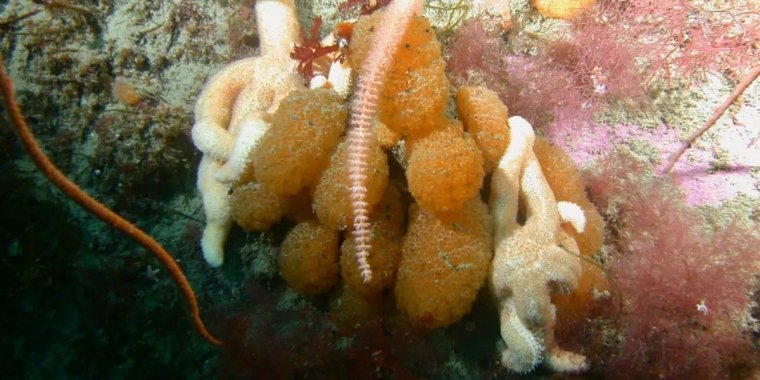| Health / Health News |
Promising anti-melanoma properties discovered in a sea squirt
Few places are farther from the medicine cabinet than the tissues of an ascidian, or "sea squirt," on the icy Antarctic seafloor -- but that’s exactly where scientists are looking to find a new treatment for melanoma, one of the most dangerous types of skin cancer.

Synoicum adareanum pictured with a starfish in 80 feet of water near Bonaparte Point, Antarctica. Photo: Bill Baker/USF
In a new paper, a team from the Desert Research Institute, Los Alamos National Laboratory and the University of South Florida made strides toward tracing a naturally-produced melanoma-fighting compound called "palmerolide A" to its source.
The source is a microbe that lives in Synoicum adareanum, a species of ascidian common to the waters of Antarctica's Anvers Island archipelago.
"We have long suspected that palmerolide A was produced by one of the many types of bacteria that live in this ascidian species," said lead author Alison Murray of the Desert Research Institute.
"Now, we have been able to identify the specific microbe that produces the compound, a huge step toward developing a naturally-derived treatment for melanoma.
"This is the first time we've matched an Antarctic natural product to the genetic machinery that's responsible for its biosynthesis. We can't go to Antarctica and harvest these sea squirts, but now that we understand the underlying genetic machinery, it opens the door for us to find a biotechnological solution to produce this compound."
To survive in the harsh and unusual environment of the Antarctic seafloor, ascidians and other invertebrates such as sponges and corals have developed symbiotic relationships with microbes that play a role in photoprotective pigments, bioluminescence, and chemical defenses.
The compounds produced by these microbes may have applications in science, health and industry. Palmerolide A is one of many examples, the scientists believe.
"Antarctic organisms have much to offer in new biochemical synthesis and its genetic machinery, and new natural products that can be developed through biotechnology to address such challenges as treating cancer," said Maria Vernet, a program director in NSF's Office of Polar Programs. (National Science Foundation)
YOU MAY ALSO LIKE





